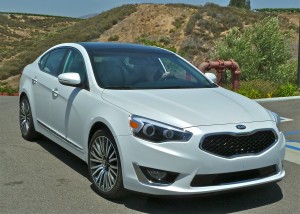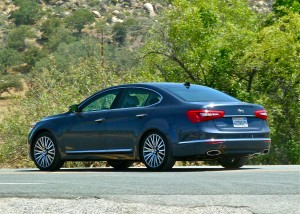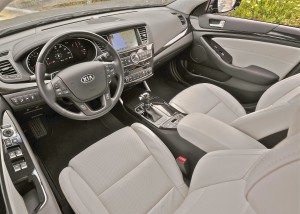Kia rides Cadenza into luxury category
By John Gilbert
Niche marketing, they call it, and auto manufacturers build all manner of vehicles aimed at specific niches. Kia is no different, successfully filling the most popular and inexpensive segments with the subcompact Rio, compact Forte, quirky Soul, classy midsize Optima, and a pair of SUVs — the compact Sportage and midsize Sorento.
But the Korean company is keenly aware of how lucrative the luxury and near-luxury segments have become, and also that it has nothing in those upscale brackets. And now it does.
For 2014, Kia is introducing the Cadenza as its first serious venture into the mid-luxury market. We don’t know what the word Cadenza means in Korean, if anything, and surely Kia will have to withstand the suggestion that adding an “r” it might turn it into a Credenza. Bedroom furniture notwithstanding, the Cadenza is a car that can stand on its own merits as a good idea at first glance, which becomes better upon further review.
Kia made an abbreviated try at a high-end sedan, with the previously discontinued Amanti, which sounded more like a fancy men’s suit than a piece of furniture, but the Cadenza is an entirely different vehicle. It has as much sporty performance as luxury in its character, and plenty of both in its streamlined marketing approach, which will be out by mid-June as only one Cadenza, with one model that can be selected in either of two trim levels. The Luxury model starts at $38,900, and the same car with the Technology package starts at $41,900.
Either way, the car comes fully equipped, and leaves a first impression of, well…surprise. After all, Kia has enjoyed a resurgence over the last three years, by carving a niche of economy and sporty-economy cars, and you normally don’t expect to find these luxury features in a Kia, by any name.
The Cadenza shares the family grille that fronts the Optima, Rio, Forte, and the SUVs, but from first glance the Cadenza rises above the rest of Kia’s herd with classy exterior styling and a complete checklist of all the latest connectivity and electronic driving-aid features. It makes it challenging to select which feature or features you like the best, but the highlight might be where you live — or at least where you sit — because all models have Nappa leather covering the front buckets and spacious rear seats, and it not only is buttery soft, but envelopes your body in a comfortably firm manner.
The Korean auto business has evolved in an interesting fashion. There once were a half-dozen manufacturers, but while Hyundai led the way by making cars by licensing them for production and growing profitably, the rest of them faltered, and one by one, dropped away. It was reduced to Hyundai, Kia and Daewoo, and as Daewoo was ready to discontinue production, it was bought out by General Motors, which made the Aveo and continues to make other small cars in Korean plants. Kia was also fading, and the Korean government worked out an arrangement with Hyundai to accept Kia as a partner.
That arrangement happened just as Hyundai had made a breakthrough in engineering technology, building its best engine, a 2.4-liter 4-cylinder, which won out in a competition with Chrysler and Mitsubishi, both of which today use that 2.4 engine design for basic power. Following up, Hyundai engineers added a high-pressure direct-injection system, while other engineers completed and perfected an in-house designed 6-speed automatic transmission that is notably lighter and smaller. All of those concepts came together in the 2011 Sonata.
A few months later, Kia brought out its 2011 Optima, its own version of the Sonata with a completely different look, designed by Peter Schreyer. Kia’s resurgence followed, led by the Optima, built in a new U.S. factory in West Point, Ga., and, as Hyundai’s partner, using the highly sophisticated Hyundai drivetrain. Since then, Kia has paralleled Hyundai models, as the engineering staff has applied its new-found expertise to larger and smaller engines. But Hyundai has kept the luxury end of the market to itself, with the Azera, built on a lengthened Sonata platform, and a pair of larger rear-wheel-drive vehicles — the Genesis and the ultra-luxury Equus, both of which are powered by Hyundai’s new V8 engine.
The Cadenza is Schreyer’s design exercise on Kia’s parallel vehicle to the Azera, essentially built on an extended Optima platform. It also uses the slick 3.3-liter V6, also used in the Azera, and which offers a horsepower and economy boost while replacing the larger 3.5 V6 in the Kia Sorento SUV. The total package makes the Cadenza Kia’s most luxurious car, powered by the most potent engine Kia has ever put in a vehicle.
“Timing is all-important,” said Orth Hedrick, Kia’s director of product planning. “Two years ago, we concentrated on the Optima, and now that it is established, we can take the next step. The Optima is more mainstream, while the Cadenza is our flagship, a premium car and a strategic vehicle for us.
“It’s highly sophisticated, and we’re focusing on it as a driver’s car, more than a ‘being driven’ car.”
Kia is aiming at having the cars readily available in June, but Kia spokesman Michael Sprague said a “couple hundred” have been sold to early shoppers, with a range in age from 24-70, with buyers trading in mostly luxury or near-luxury cars.
The Cadenza hints at a more European design, which makes sense, since Schreyer designed vehicles for Audi before Kia lured him away. Plus, Europe seems to have command of the sports-luxury sedan touch, although the Cadenza performed with All-American flair during the introductory road test, which started in the San Diego suburb of Del Mar and wound through the Southern California wine area before also reaching the Pacific Coast Highway.
Revised with direct injection, the 3.3 — actually 3,342 cc. — has 293 horsepower at 6,400 RPMs and 255 foot-pounds of torque at 5,200. The engines are run for 300 hours at redline, and then an additional 20 hours at 10 percent higher revs than redline, to underscore durability beyond normal performance.
The 6-speed automatic transmission has AutoSport, with steering wheel paddles to manually override the shifting. In virtually all models that parallel Hyundai cars, the Kia versions are tuned to be slightly sportier, with firmer handling, and the Cadenza lives up to that standard, with its MacPherson strut front suspension and multilink rear, and with coil springs and stabilizer bars front and rear.
With that sort of equipment, the Cadenza is readily prepared to run with mid-luxury sedans that lean toward the hotter sports sedan side. The 3.3 revs freely and sounds good doing it, and the 6-speed automatic is smooth and efficient when it automatically does its work, or when you use the paddles and run up the revs for each manual shift. The suspension also holds firm on the curviest of mountain roadways, yet remains compliant over uneven pavement and potholes without a hint of harshness.
Its size never approaches large-car heft, but the Cadenza, at 195.5 inches, is about 5 inches longer than the midsize Optima, and is also a half-inch wider at 72.8 inches, and almost an inch taller at 58.1. Interior room benefits by the slightly larger interior dimensions, and a 15.9 cubic foot trunk is another family-friendly feature. Fully 60 percent of the Cadenza’s body is made of high-tensile steel — an expensive commodity that is readily available with Hyundai owning its own steel plant. The Cadenza is quite heavy, at 3,668 pounds, but the V6’s potency makes the overall package feel lighter and more agile than that.
While some suspected the Cadenza might be a version of Hyundai’s Genesis, those in wintry driving areas can celebrate that it instead is more Azera sized, because that means it has front-wheel drive, and offers optimal foul-weather traction as the next-best-thing to all-wheel drive.
At $38,900, the Cadenza has a richly appointed interior in its Luxury form. The impressive seats have 10-way electric adjustment for the driver, with heat or ventilation provided through the Nappa leather, and wherever you poke your finger you find soft-touch material. A classy wood trim with tasteful touches of chrome further add the luxury feeling to the interior. A 7-inch LCD instrument screen is high-tech, and a full-length sunroof is something else that is almost a Kia staple on various cars. Also, a power rear sunshade can make life in the rear seat far more pleasant, while also giving the driver a break from glare when driving away from the sun.
The Cadenza fits nicely in the entry-luxury region, and offers, along with its 10-year, 100,000-mile warranty, free scheduled maintenance for the first five sessions, covering 36 months or 37,500 miles. A 550-watt Infinity sound system with 12 speakers, including rear surround speakers and a subwoofer, adds to the luxurious technology that meets or exceeds expectations in that price range.
Bluetooth connectivity is by now expected in such cars, and the Cadenza doesn’t disappoint. If you choose the Technology package, your Cadenza goes from 18 to specific 19-inch alloy wheels, and the driver seat adjustment upgrades from 10-way to 12-way, plus it gains an electric parking brake, auto-hold for starting on a hill without rolling backwards, and a Smart Cruise feature that will haul the car to a complete stop by itself if the driver isn’t braking hard enough to miss an object detected in the road ahead. A radar-operated blind-spot detection feature, and lane-change assist with unsignaled lane-departure warning also is a neat addition, as are projector beam headlights and foglights. A rear-view camera is displayed on an 8-inch navigation screen in the middle of the center stack, which, along with the 7-inch instrument cluster, gives a high-tech video appearance.
Some of those features are expected, some go beyond, but cars that have as many as the Cadenza normally cost well north of the Cadenza’s $40,000 range.
Comments
Tell me what you're thinking...
and oh, if you want a pic to show with your comment, go get a gravatar!





 John Gilbert is a lifetime Minnesotan and career journalist, specializing in cars and sports during and since spending 30 years at the Minneapolis Tribune, now the Star Tribune. More recently, he has continued translating the high-tech world of autos and sharing his passionate insights as a freelance writer/photographer/broadcaster. A member of the prestigious North American Car and Truck of the Year jury since 1993. John can be heard Monday-Friday from 9-11am on 610 KDAL(www.kdal610.com) on the "John Gilbert Show," and writes a column in the Duluth Reader.
John Gilbert is a lifetime Minnesotan and career journalist, specializing in cars and sports during and since spending 30 years at the Minneapolis Tribune, now the Star Tribune. More recently, he has continued translating the high-tech world of autos and sharing his passionate insights as a freelance writer/photographer/broadcaster. A member of the prestigious North American Car and Truck of the Year jury since 1993. John can be heard Monday-Friday from 9-11am on 610 KDAL(www.kdal610.com) on the "John Gilbert Show," and writes a column in the Duluth Reader.